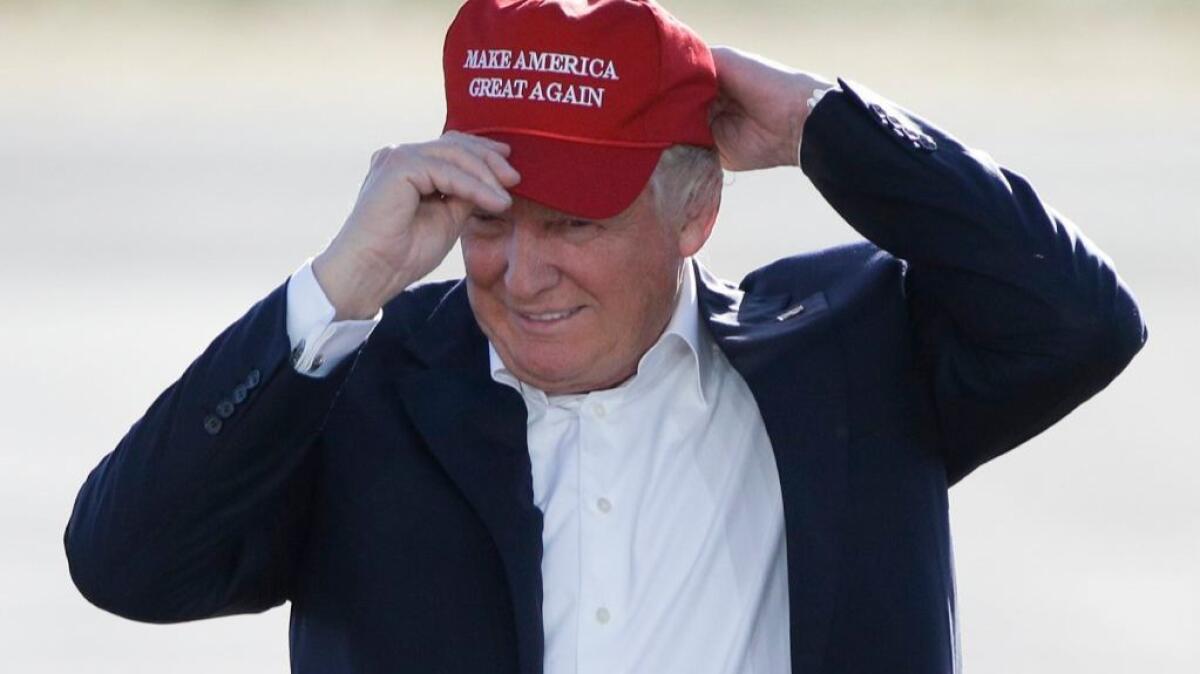Opinion: Does a kid in a pro-Trump shirt make a classroom unsafe?

- Share via
When he was running for president, Donald Trump alarmed 1st Amendment enthusiasts when he threatened to “open up our libel laws.”
It was a pretty hollow threat. For one thing, libel laws are enacted at the state level; the primary way the president can affect libel law is through his appointments to the Supreme Court, which ensures that libel lawsuits comport with the Constitution. Ironically, Justice Neil Gorsuch, Trump’s only appointee to the court, has a record as an appeals court judge of protecting the media in libel actions.
But there is another area of the law in which Trump might pose a threat to 1st Amendment: free speech for students in public schools.
In 1969, in Tinker vs. Des Moines School District, the Supreme Court ruled in favor of students who were suspended for coming to school wearing black armbands to protest the Vietnam war.
In a line that has rung ominously in the ears of generations of school administrators, the court said that schoolchildren don’t “shed their constitutional rights to freedom of speech or expression at the schoolhouse gate.”
Schools could suppress student speech, Justice Abe Fortas wrote, only when administrators had a reasonable expectation that the speech would cause “substantial disruption of or material interference with school activities,” or when the speech would violate the rights of other students.
The Tinker decision remains unpopular not only with school administrators but also with some members of the court. Justice Clarence Thomas has noted approvingly that “in the earliest public schools, teachers taught, and students listened. Teachers commanded, and students obeyed.” Tinker, he complained, extended students’ rights “beyond traditional bounds.”
But while Tinker has been applied inconsistently – including by the Supreme Court – it remains good law.
Enter Donald Trump. And exit Lyn Orletsky.
This week the Atlanta Journal-Constitution reported that Orletsky submitted her resignation as a high school math teacher to the Cherokee County school board in Georgia. The board had placed her on leave in September after she requested that two students wearing “Make America Great Again” T-shirts turn them inside out.
In this video, Orletsky explains her reasoning: It wasn’t about Trump, she says. Her classroom at River Ridge High School was 30% minority and “all of these kids have the right to feel comfortable in my classroom. And, unfortunately, since Charlottesville, this slogan ‘Make America Great Again’ has been appropriated by a number of hate groups, a number of neo-Nazi groups.”
The case of the MAGA shirts recalls a similar controversy in California that ended up in federal court. In 2010, some white students at Live Oak High School near San Jose came to school on Cinco de Mayo wearing shirts that incorporated the American flag.
Worried that Latino students might see the shirts as a nativist provocation – and recalling that a year earlier Latino students had reacted with threats when white students hung an American flag – administrators told the students to either turn their shirts inside out or take them off. Two students who refused were told to go home.
The students who wore the flag shirts sued the Morgan Hill Unified School District, claiming their 1st and 14th Amendment rights had been violated. But the U.S. 9th Circuit Court of Appeals rejected their claim, holding that the possibility of an “altercation” justified the decision to order them to remove or hide their shirts.
That decision could be squared with Tinker. It’s harder to argue that allowing students to wear “Make America Great Again” T-shirts posed the risk of substantial disruption.
Did it violate the other standard set out in Tinker, of violating the rights of other students “to be secure and to be let alone”? Probably not. There is no right to feel “comfortable.” (Orletsky also says she wanted her students to be “safe” in her classroom, but she doesn’t seem to be talking about physical safety.)
Orletsky’s resignation suggests that this incident isn’t likely to result in a court decision. But the Trump administration is young. And given the president’s penchant for polarizing rhetoric and dog whistles, other teachers are likely to share Orletsky’s apprehensions when they see a student wearing a MAGA hat or T-shirt, especially in a racially and religiously diverse classroom.
If they and their principals order the students to remove those garments, and the kids and their parents go to court, even some liberal judges may come to perceive wisdom in Justice Thomas’ objections to student free speech.
Follow the Opinion section on Twitter @latimesopinion and Facebook
More to Read
A cure for the common opinion
Get thought-provoking perspectives with our weekly newsletter.
You may occasionally receive promotional content from the Los Angeles Times.










